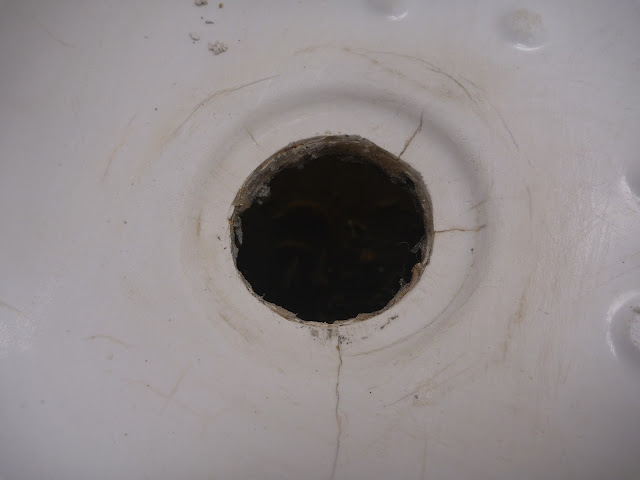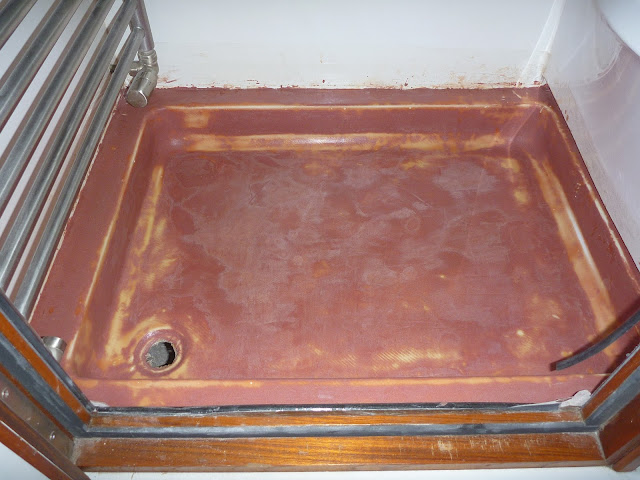I mentioned in this blog whilst converting Jim into a motorhome, that I was trying as far as possible to avoid using fixtures and fittings from caravan and motorhome suppliers, partly because they tend to be fugly (technical term), and partly because they have the resilience of a chocolate tea pot. In general I managed to stick to this ambition, and I largely used parts from marine and industrial suppliers. In the bathroom however, I broke my pledge, and bought a series of matching plastic pieces that combine to make a reasonably attractive moulded bathroom suite. To replicate the appearance and functionality of these items in something tougher like fibreglass would have taken me a significant chunk of time, and so I took the lazy option. Below is a photo taken whilst I was installing the items in May 2012.
As soon as I picked up the shower tray component of this suite, I knew the decision would bite me on the arse, but I thought that a hefty amount of plywood and sikaflex reinforcement would be enough to prevent it from falling apart. I bonded a sheet of plywood across the bottom of the tray, and supported all four edges with a plywood upstand. In hindsight I completely underestimated the utter uselessness of the original product. I hate calling anyone out without giving them a chance to defend themselves but in this case the shower tray that I bought from CAK Tanks to match the C400 type Thetford cassette toilet was so appallingly low quality that I feel compelled to advise others to either not waste their time, or to simply use it as a mould to make a better version out of fibreglass.

I must acknowledge the awesome abilities of the CT1 adhesive that I used as a temporary repair to the tray whilst we were travelling. It is described as a hybrid polymer adhesive sealant, and it worked remarkably well to seal all of the damage and prevent water leaking into the area under the tray. When I first used it, I expected it peel off, as the cracks flexed. But it stuck the tray far better than the Sikaflex I used to bond the reinforcement pieces, and remained flexible enough to absorb the significant movement in the cracks around the edge of the tray. Unfortunately as well as it worked to prevent leaks, it made the shower tray look shabby, and ultimately I couldn’t live with the shame of such a visible bodge.
The way in which I constructed the bathroom in Jim would make it a massive ball ache to remove and replace the shower tray, and whilst I acknowledge that this may be in my future, I decided to first try and repair/rebuild the shower tray in-situ. The easiest way that I could think to repair the damage, was to fibreglass over the existing shower, effectively building a new tray inside the old one. The only snag in this plan was finding a way to get the new tray to bond effectively to the old one. Having a fair amount of epoxy resin left in the shed, I decided to use this for the fibrglassing, but I knew from experience that there are many plastics that epoxy does not effectively adhere to. My first step was to try to find out which plastic the tray was made from.
It is obvious from the feel of the tray that it made by vacuum forming, rather than injection moulding, and so this already limits the number of plastics which the tray could be made from. I then got a few thinners/solvents out of the back of the shed, and experimented to see which ones would soften or dissolve the surface of the shower tray. I then referred to an online compatibility chart, and established with a reasonable degree of certainty that the tray was made from PVC. This is certainly easier to bond to that polyethylene of polypropylene, but still required some extra work. Following advice that I found online, I sanded the tray using 80 grit paper, and flame treated the plastic using a propane torch to burn of the oily residue and promote adhesion. I experimented with some of epoxy I had in the shed, and found that using this surface preparation, the resin bonded acceptably well. The cured resin could be chipped of using a Stanley knife, but it did not peel off in a sheet.
The shower tray came with a grid of raised dimples across the base, to make the surface more grippy. I suspected that the profile of the dimples would have been too severe for the fibreglass cloth to conform too, and would have left me with air pockets behind the cloth, and so I started the job by sanding all of the dimples off, leaving a smooth surface on which I could lay the cloth.
West Systems make a specialist (and expensive) epoxy resin from repairing plastic components called G-flex, and so I bought enough to ‘wet-out’ the surface of the tray and help to prevent delamination in the future. G-flex is too thick to wet out cloth properly anyway, and makes a poor fairing filler as it is too thick to absorb sufficient filler to allow easy sanding, and so I reverted to standard resin for the rest of the work.
I used the following system for glassing over the tray:
- G-flex epoxy to wet-out the surface;
- One layer of 280 gram twill weave wetted out with three coats of standard west systems resin;
- A thick layer of fairing resin using micro-balloon filler; and
- Two coats of resin as a barrier coat.
I had absolutely no experience of using fibreglass prior this job, but information online suggested that I should use cloth rather than matt to improve strength and surface appearance, and that twill weave was a good compromise between strength and ability to conform to compound curves.
The fairing took longer than I expected, mostly as a result of the internal corners being a pain to sand, but the final surface was as good as it needed to be, and I was pleased to have escaped my first experience with fibreglass unscathed. Time will tell whether I should have used multiple layers of cloth, but the tray has far less flex in it than previously.
The final task was to paint the tray, and silicone the edges to seal it to the wall. I had originally intended to use a non-slip decking paint to prevent an embarrassing call for help whilst crumpled and naked on the floor of the bathroom, but I was convinced by SWMBO to use a gloss paint instead to make cleaning easier. The gloss looks good, and in that respect it was a good decision, but I’m doubtful that I’ll be able to escape from a drunken trip to the toilet without ending up on my arse. The gloss surface will undoubtedly need repainting every once in a while, but if I find that it does not hold up well (particularly to people wearing shoes when going to the toilet), I’ll invest in a pot of two-part polyurethane paint.
Whilst I was at it, I replaced the previous waste trap with one with a deeper water seal. I’m not sure why I bought such a shallow one previously, but it blocked up with hair every few months and needed cleaning. It is easy to remove the base of the trap from outside the truck, but retrieving clumps of matted hair and dirty water from a blocked trap is something I prefer to keep for special occasions.
So far the repair seems to be a success, but it won’t be until we take another extended trip in the truck that I know for sure whether the new tray is strong enough and stuck well enough to the old one to be a permanent fix.












No comments:
Post a Comment